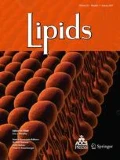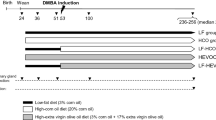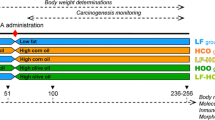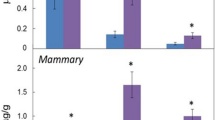Abstract
The comparative effects of high-fat diets (20%, w/w) on eicosanoid synthesis during mammary tumor promotion in 7,12-dimethylbenz(a)anthracene (DMBA)-induced rats were studied using diets containing 20% primrose oil (PO), 20% menhaden oil (MO) or 20% corn oil (CO). Sprague-Dawley rats fed the PO or MO diet had 21% or 24% fewer adenocarcinomas, respectively, than rats fed the CO diet. Histologically (i.e., mitotic figures, inflammatory cell infiltration and necrosis), the CO-fed rats exhibited the highest frequency of changes within tumors. Plasma fatty acid composition was significantly altered by diet, reflecting the composition of the oils which were being fed. Only the plasma of PO-fed rats contained detectable levels of gamma-linolenic acid (GLA). Arachidonic acid (AA) levels were significantly higher (p<0.05) in PO-fed than in CO- or MO-fed rats. MO-fed rats had significantly higher levels of plasma palmitic acid, while palmitoleic, eicosapentaenoic (EPA) and docosahexaenoic (DHA) acids were detected only in MO-fed rats. As expected, linoleic acid (LA) and AA levels were lower (p<0.05) in the MO-fed rats than in PO- or CO-fed groups. The plasma of the CO-fed rats contained significantly higher levels of oleic acid. Eicosanoid synthesis in mammary carcinomas of rats fed the 20%-fat diets was 2–10 times higher than in mammary fat pads of control rats. The synthesis of PGE1 and LTB4 was significantly (p<0.05) higher in PO-fed rats than in CO-fed or MO-fed rats, although PGE values were significantly (p<0.05) higher in CO-fed rats than in Mo or PO groups. The synthesis of eicosanoids in both mammary fat pads and mammary carcinomas of MO-fed rats was lower (p<0.05) than in tissues of rats fed either CO or PO diets due to less AA precursor being fed and/or to competition between n−6 and n−3 fatty acids for cyclooxygenase and lipoxygenase. The ratios of monoenoic to dienoic eicosanoids in both mammary fat pads and mammary carcinomas were higher in the PO group than in the MO or CO groups. These results suggest that inclusion of GLA (PO feeding) or EPA and DHA (MO feeding) in the diet may decrease malignancy by altering eicosanoid profiles.
Similar content being viewed by others
Abbreviations
- AA:
-
arachidonic acid
- CO:
-
corn oil
- DGLA:
-
dihomogamma-linolenic acid
- DHA:
-
doeosahexaenoic acid
- DMBA:
-
7,12-dimethylbenz(a)anthracene
- D6D:
-
delta-6 desaturase
- EFA:
-
essential fatty acid
- EPA:
-
eicosapentaenoic acid
- GLA:
-
gamma-linolenic acid
- LA:
-
linoleic acid
- MO:
-
menhaden oil
- PO:
-
primrose oil
- RIA:
-
radioimmunoassay
References
Welsch, C. (1985)Cancer Res. 45, 3415–3443.
Ip, C., Carter, C.A., and Ip, M.M. (1985)Cancer Res. 45, 1997–2001.
Lee, S.Y., and Rogers, A.E. (1985)Nutr. Res. 3, 361–371.
Rao, G.A., and Abraham, S. (1976)J. Natl. Cancer Inst. 56, 431–432.
Karmali, R.A. (1986) inDietary Fat and Cancer (Ip, C., Birt, D.F., Rogers, A.E., and Mettlin, C., eds.) pp. 687–697, Alan R. Liss Inc., New York, NY.
Carter, C.A., Milholland, R.J., Shea, W., and Ip, M.M. (1983)Cancer Res. 43, 3559–3562.
Karmali, R.A. (1987)Am. J. Clin. Nutr. 45, 225–229.
O'Connor, T.P., Roebuck, B.D., Peterson, F., and Campbell, T.C. (1985)J. Natl. Cancer Inst. 75, 959–962.
Jurkowski, J.J., and Cave, Jr., W.T. (1985)J. Natl. Cancer Inst. 74, 1145–1150.
Gabor, H., and Abraham, S. (1986)J. Natl. Cancer Inst. 76, 1223–1229.
Cave, Jr., W.T. and Jurkowski, J.J. (1987) inProceedings of the AOCS Short Course on Polyunsaturated Fatty Acids and Eicosanoids (Lands, W.E.M., ed.) pp. 261–266, American Oil Chemists' Society, Champaign, IL.
Braden, L.M., and Carroll, K.K. (1986)Lipids 21, 285–288.
Crawford, M.A. (1987) inProceedings of the AOCS Short Course on Polyunsaturated Fatty Acids and Eicosanoids (Lands, W.E.M., ed.) pp. 270–294, American Oil Chemists' Society, Champaign, IL.
Holman, R.T. (1986)Prog. Lipid Res. 25, 29–39.
Abou-El-Ela, S.H., Prasse, K.W., Carroll, R., and Bunce, O.R. (1987)Lipids 22, 1041–1044.
Ghayur, T., and Horrobin, D.F. (1981)IRCS Med. Sci. 9, 582.
Karmali, R.A., Marsh, J., and Fuchs, C. (1985)J. Nutr. Growth Cancer 2, 41–51.
National Research Council (1978) inNutrient Requirements of Laboratory Animals (3rd edn.) National Academy of Sciences, Washington, DC.
Folch, J., Lees, M., and Sloane Stanley, G.H. (1957)J. Biol. Chem. 226, 497–509.
Morrison, W.R., and Smith, L.M. (1964)J. Lipid Res. 5, 600–608.
Rydzik, R.M. (1984) in “Characterization and Pharmacological Properties of Unknown Eicosanoids,” pp. 68, Ph.D. Dissertation, University of Georgia, Athens, GA.
Van Zwieten, M.J. (1984) inThe Rat as Animal Model in Breast Cancer Research (Van Zwieten, M.J., ed.) pp. 53–134, Martinus Nijhoff, Boston, MA.
Wade, A.E., Dharwadkar, S., Bunce, O.R. and Abou El-Ela, S.H. (1988)Drug Nutrient Interactions, in press.
Karmali, R.A. (1987) inProceedings of the AOCS Short Course on Polyunsaturated Fatty Acids and Eicosanoids (Lands, W.E.M., ed.) pp. 222–232, American Oil Chemists' Society, Champaign, IL.
Korchak, H.M., and Abramson, S.B. (1985) inProstaglandins and Immunity (Goodwin, J.S., ed.) pp. 179–202, Martinus Nijhoff Publishing, Boston, MA.
Honn, K.V., Bockman, R.S., and Marnett, L.J. (1981)Prostaglandins 21, 833–864.
Honn, K.V., Busse, W.D., and Sloan, B.F. (1983)Biochem. Pharmacol. 32, 1–11.
Erickson, K.L. (1986)J. Immunopharmacol. 8, 529–543.
Ham, E.A., Soderman, D.D., Zanetti, M.E., Dougherty, H.W., McCauley, E., and Kuehl, F.A. (1983)Proc. Natl. Acad. Sci. USA 80, 4349–4353.
Lee, T.H., and Austen, K.F. (1986)Adv. Immunol. 39, 145–175.
Author information
Authors and Affiliations
About this article
Cite this article
Abou-El-Ela, S.H., Prasse, K.W., Carroll, R. et al. Eicosanoid synthesis in 7,12-dimethylbenz(a)anthracene-induced mammary carcinomas in Sprague-Dawley rats fed primrose oil, menhaden oil or corn oil diet. Lipids 23, 948–954 (1988). https://doi.org/10.1007/BF02536342
Received:
Accepted:
Issue Date:
DOI: https://doi.org/10.1007/BF02536342




